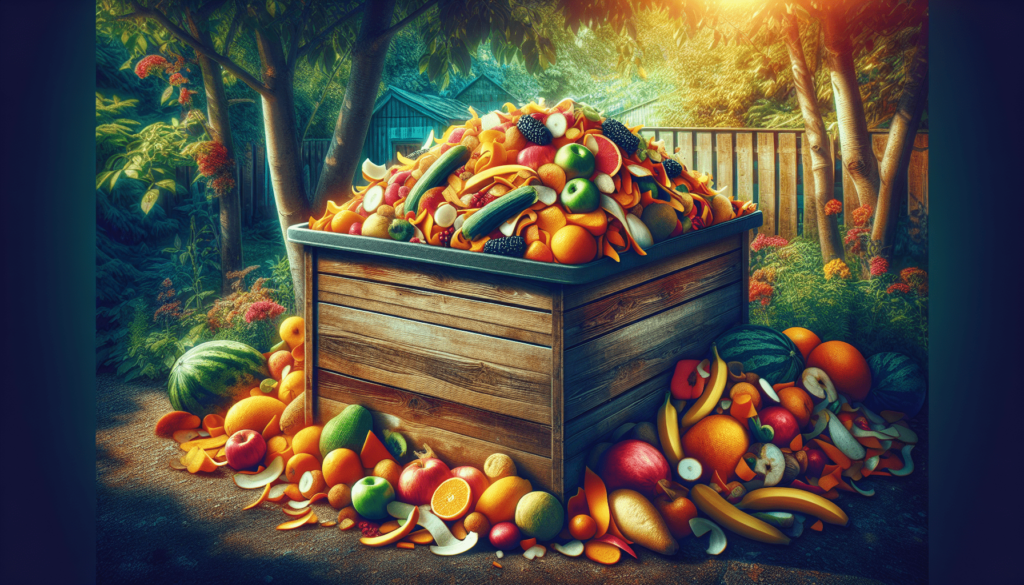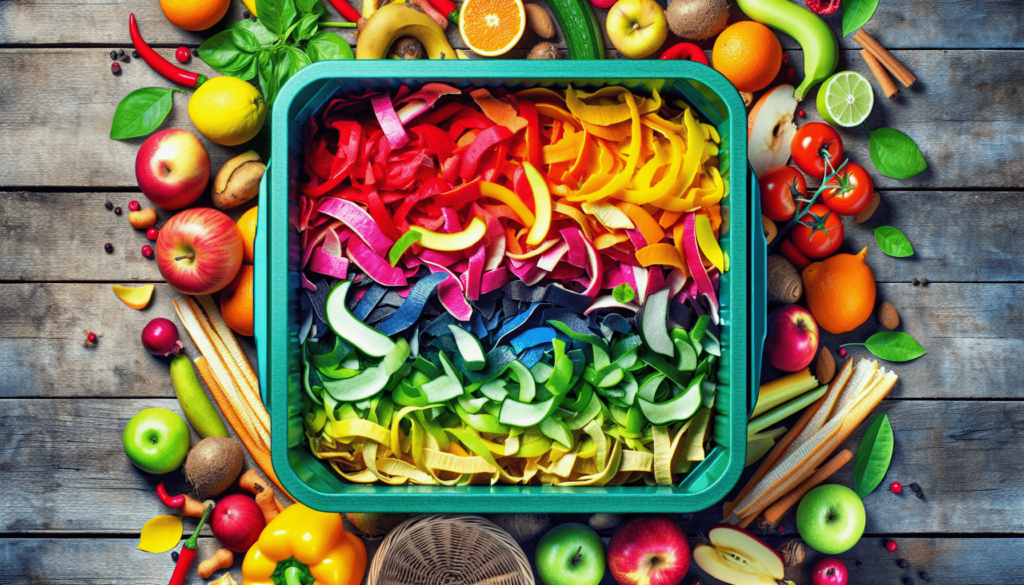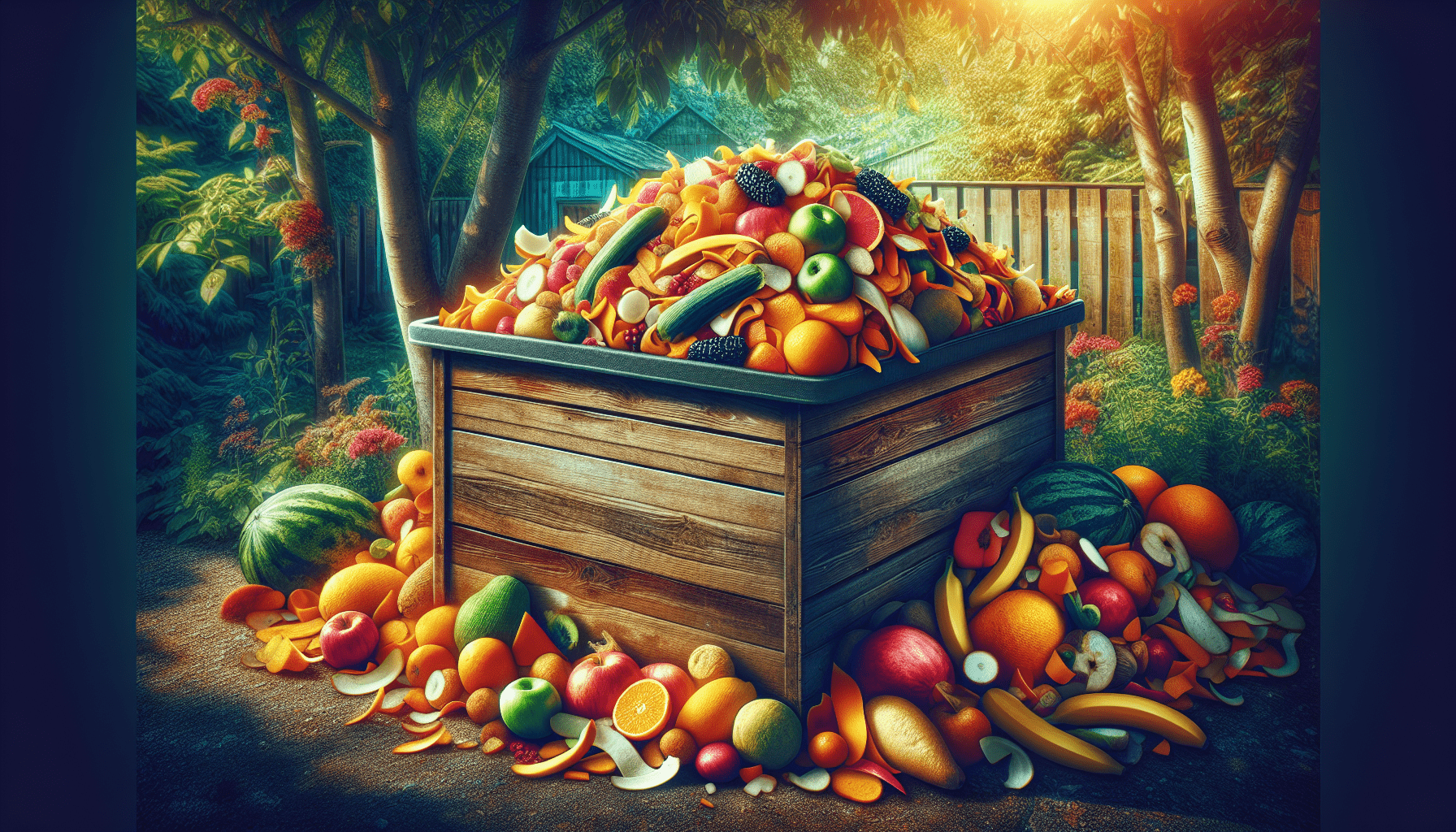Hey there! We all want to do our part in reducing waste and taking care of the environment. So, how can you specifically cut down on food waste in your very own household? In this article, we’ll explore some simple yet effective strategies that you can start implementing today. From smart meal planning and proper storage tips to creative ways to use leftovers, you’ll discover practical solutions that not only save you money but also contribute to a more sustainable future. So, let’s dive in and learn how you can make a difference in reducing food waste at home!
Meal Planning
Create a Weekly Meal Plan
Creating a weekly meal plan can be a game-changer when it comes to reducing food waste in your household. By taking the time to sit down and think about what meals you will prepare throughout the week, you can better estimate the quantity of ingredients you will need. With a plan in place, you’ll be less likely to buy excess groceries that may end up going to waste.
Make a Shopping List
Once you’ve created your weekly meal plan, it’s time to make a shopping list. This list will serve as your roadmap when you’re at the grocery store, helping you stay focused and avoid impulse purchases. Be sure to check your pantry and fridge before heading out to ensure you don’t buy duplicates of items you already have. Having a detailed shopping list will also save you time and energy by reducing the need for multiple trips to the store.
Stick to the List
While it may be tempting to veer off course and grab something that catches your eye, it’s important to stick to your shopping list. Impulse buys can often lead to ingredients sitting unused in your pantry or fridge, ultimately leading to food waste. By staying disciplined and only purchasing what you truly need, you’ll be taking a big step towards reducing food waste in your household.
Plan for Leftovers
Another smart strategy in meal planning is to intentionally cook more than you need for one meal, with the intention of having leftovers. Leftovers can be a valuable asset in reducing food waste, as long as they are not forgotten and left to spoil in the back of the fridge. Plan to incorporate these leftovers into future meals or pack them for lunch the next day. This way, you’re utilizing all the food you have on hand and minimizing waste.
Smart Shopping
Buy Only What You Need
One of the most effective ways to reduce food waste is to buy only what you need. When grocery shopping, it’s easy to get carried away and purchase more food than you can realistically consume before it spoils. To avoid this, carefully plan your meals, create a shopping list, and resist the temptation to make impulse purchases.
Check Expiration Dates
Before adding a product to your cart, take a moment to check its expiration date. By selecting items with a longer shelf life, you can extend the time in which you have to consume them. Additionally, be mindful of the expiration dates on perishable items like dairy products and meats. Choosing items with a later expiration date can help prevent food waste by giving you more time to use them.
Don’t Shop on an Empty Stomach
We’ve all been there – hungry and wandering the grocery store aisles without a solid plan. Shopping on an empty stomach can lead to poor decision-making, as you’re more likely to make impulsive purchases and overbuy. Eat a meal or a snack before heading to the store to ensure you have a clear mind and make smart choices that align with your meal plan.
Buy in Bulk Wisely
Buying in bulk can be cost-effective and reduce unnecessary packaging waste. However, it’s important to buy in bulk wisely to avoid food waste. Only purchase perishable items in bulk if you know you can consume them before they spoil. For non-perishable items, consider sharing bulk purchases with friends or family members to prevent waste and save money.

Proper Food Storage
Organize Your Fridge and Pantry
An organized fridge and pantry can help you maximize the use of ingredients and minimize food waste. Make sure to regularly clean and declutter these spaces, removing any expired or spoiled items. Arrange your groceries in a way that allows you to see everything you have, reducing the chances of forgetting about items and letting them go to waste.
Use Clear Containers
Investing in clear containers can revolutionize your food storage system. Being able to see the contents of each container at a glance reduces the likelihood of forgetting about leftovers or ingredients. When you can easily see what you have, you’re more likely to use it before it spoils.
Label Foods and Dates
To avoid confusion and food waste, make it a habit to label foods and dates. This is especially important for leftovers and homemade items that may not have clear expiration dates. By including the date of preparation or the “use-by” date, you’ll have a clear reference point and can easily incorporate these items into future meals before they spoil.
Store Foods at the Right Temperature
Different types of food require different storage temperatures to maintain their freshness and quality. Pay attention to the instructions on the packaging and do some research on the optimal storage conditions for various items. For example, some fruits and vegetables are best stored at room temperature, while others should be refrigerated. By storing foods at the right temperature, you can extend their shelf life and reduce waste.
Understanding Expiration Dates
Know the Difference: Use By, Best By, Sell By
Understanding the different types of expiration dates can help you make informed decisions about the food you consume. “Use By” dates indicate the last date recommended for consuming the product at its peak quality, while “Best By” dates suggest the optimal period for consuming the product for the best taste. “Sell By” dates, on the other hand, are used by retailers to indicate the date by which the product should be sold. It’s important to note that these dates are not strict indicators of food safety but rather guidelines for quality.
Understand Food Spoilage Signs
In addition to expiration dates, knowing the signs of food spoilage can help prevent waste. Mold, unusual odors, slimy textures, and discoloration are all indications that a food item has gone bad and should be discarded. Develop a habit of regularly checking your perishable items for these signs to catch any potential spoilage before it spreads.
Utilize the Freezer for Extended Storage
When you find yourself with excess food that you won’t be able to consume in time, the freezer can be your best friend. Freezing food can extend its shelf life significantly, allowing you to enjoy it at a later date. However, it’s essential to properly package and label frozen items to maintain their quality. Use airtight containers or freezer bags to prevent freezer burn and include the date of freezing to ensure you use the oldest items first.
Rotate Stock to Avoid Expired Food
To avoid having expired food hidden at the back of your pantry or fridge, practice the “first in, first out” rule. When you buy groceries, move the older items to the front and place the newer ones in the back. This way, you’ll naturally use the older items first, reducing the chances of forgetting about them and letting them expire.

Creative Leftovers
Reinvent Leftovers into New Meals
Leftovers don’t have to be boring! Get creative and transform them into completely new meals. For example, yesterday’s roasted chicken can become today’s chicken tacos or tomorrow’s chicken salad. Look for recipes online or experiment with your own flavor combinations to breathe new life into your leftovers.
Pack Leftovers for Lunch
Instead of letting leftovers sit in your fridge for days on end, pack them up for lunch. Not only does this save you time and money, but it also prevents those leftovers from eventually being discarded. Invest in some reusable food containers that are easy to pack and transport, ensuring your leftovers stay fresh until lunchtime.
Freeze Leftovers for Future Use
If you find yourself with an abundance of leftovers, consider freezing them for future use. Soups, stews, and casseroles are all great candidates for freezing. Portion them out into individual servings and store them in freezer-safe containers or freezer bags. This way, you’ll always have a quick and convenient meal option readily available, without the risk of food waste.
Make Soup from Scraps
Don’t let vegetable scraps go to waste – use them to make a delicious homemade soup. Keep a dedicated container in your freezer to collect scraps like carrot ends, onion peels, and celery leaves. Once the container is full, simply add some water, herbs, and spices, and simmer it all together to create a flavorful broth. Not only are you reducing waste, but you’re also creating a nutritious and cost-effective meal.
Reduce Portion Sizes
Serve Smaller Portions
Be conscious of portion sizes when preparing and serving meals. Start by serving smaller portions and allow yourself the option to have seconds if you’re still hungry. By doing so, you can prevent over-serving and reduce the amount of uneaten food left on plates.
Offer Seconds Instead of Over-Serving
Rather than piling everyone’s plates high with food, encourage family members and guests to take smaller portions initially. By offering seconds instead of over-serving from the start, you give everyone the opportunity to take only what they can comfortably eat. This approach can help prevent waste and ensure that everyone’s appetite is satisfied.
Save Leftovers Before Eating
Before you sit down to enjoy your meal, preemptively pack away any leftovers. By saving them before you eat, you eliminate the temptation to eat larger portions than necessary just to avoid wasting food. Not only will this practice help reduce food waste, but it can also contribute to healthier eating habits.
Use Smaller Plates and Bowls
The size of your plates and bowls can subconsciously influence the amount of food you consume. Using smaller dinnerware can help control portion sizes and prevent overeating. By serving meals on smaller plates and bowls, you’ll be less likely to serve yourself more food than you can comfortably eat, leading to less waste.
Composting
Setup a Compost Bin or Pile
Composting is a fantastic way to reduce food waste and create nutrient-rich soil for your garden. Set up a compost bin or pile in your backyard, or explore options for indoor composting if you don’t have access to outdoor space. Composting not only diverts organic waste from the landfill but also helps you give back to the environment by enriching your soil.
Separate Food Scraps
As you prepare meals, separate your food scraps into a designated container or compost bin. This can include things like vegetable trimmings, coffee grounds, eggshells, and fruit peels. Keeping a small compost bin in your kitchen makes it easy to collect these scraps and prevents them from ending up in the trash.
Add Yard Waste for Balance
For successful composting, it’s important to balance your compost bin or pile with a mix of kitchen scraps and yard waste. Collect fallen leaves, grass clippings, and small branches to add to your compost. This mixture of organic matter will help create a well-balanced and nutrient-rich compost.
Use Compost in Your Garden
Once your compost has decomposed and turned into nutrient-rich soil, use it in your garden to nourish your plants. Compost is a natural fertilizer that can improve soil structure, promote healthy plant growth, and reduce the need for chemical fertilizers. By closing the loop and using your compost in your garden, you’re completing the cycle of sustainability.
Donate and Share Food
Donate Excess Food to Local Charities
If you find yourself with excess food that you can’t consume or freeze, consider donating it to local charities. Many organizations accept non-perishable food items as well as fresh produce. Contact local food banks, shelters, or community organizations to inquire about their donation procedures and any specific items they may be in need of.
Share with Neighbors or Shelter Residents
If you have extra food that you think might be appreciated by your neighbors or residents of nearby shelters, consider sharing it with them. Whether it’s fresh-baked cookies or a surplus of vegetables from your garden, small acts of kindness can go a long way in reducing food waste and building a sense of community.
Participate in Food Drives
Keep an eye out for food drives in your community and actively participate in them. These events are a wonderful opportunity to donate non-perishable items and support those in need. Check with your local churches, schools, or community centers for information on upcoming food drives and how you can contribute.
Join Food-Sharing Apps or Platforms
In today’s digital age, there are numerous apps and platforms that connect individuals and businesses with surplus food to those in need. Consider joining these platforms to share your excess food with those who can benefit from it. Sharing food not only reduces waste but also fosters a sense of community and compassion.
Utilize Food Preservation Techniques
Canning Fruits and Vegetables
Canning is an excellent method for preserving fruits and vegetables, allowing you to enjoy them long after their peak season. By sterilizing jars, packing them with your chosen produce, and sealing them, you can create a stock of homemade jams, pickles, and canned goods. This not only reduces waste but also enables you to savor the flavors of your favorite fruits and vegetables throughout the year.
Pickling and Fermenting
Pickling and fermenting are ancient preservation techniques that add a unique and tangy flavor to foods. Whether it’s pickled cucumbers, sauerkraut, or kimchi, these preserved foods can last for months in your fridge, packing a punch of flavor and probiotics. Get creative with your pickling recipes and experiment with different spices and flavor combinations.
Freezing for Long-Term Storage
Freezing is a simple and effective way to preserve food for extended periods. Many foods can be safely frozen, ranging from raw ingredients like meat and vegetables to fully cooked meals. To maintain quality, package foods in freezer-safe containers or bags, removing as much air as possible. Don’t forget to label your frozen items with the name and date of freezing for easy identification.
Dehydrating for Extended Shelf Life
Dehydrating food removes its moisture content, significantly extending its shelf life. Invest in a food dehydrator or use your oven on a low temperature to dehydrate fruits, vegetables, and herbs. Dehydrated foods can be enjoyed as healthy snacks or later rehydrated in soups, stews, and other dishes. By dehydrating your surplus produce, you can prevent spoilage and enjoy it long after the harvest season.
Educate and Involve Family Members
Teach Children About Food Waste
Educating your children about the importance of reducing food waste can have a lasting impact on their habits and behaviors. Involve them in the meal planning process, teach them about expiration dates and signs of spoilage, and show them the steps you’re taking as a family to reduce waste. By instilling these values at a young age, you’re setting the stage for a more sustainable future.
Involve Everyone in Meal Planning
Make meal planning a collaborative effort by involving everyone in your household. Encourage family members to share their favorite meals and work together to create a weekly meal plan. By involving everyone, you not only ensure that meals suit everyone’s tastes but also increase the likelihood that they’ll be enjoyed and leftovers will be eaten.
Encourage Responsible Use of Leftovers
Teach your family members how to responsibly use leftovers by demonstrating creative ways to repurpose them into new meals. Show them how to pack leftovers for lunch or freezer storage and explain the benefits of doing so. Encouraging responsible use of leftovers instills a sense of gratitude and ensures that food doesn’t go to waste.
Set an Example for Sustainable Practices
As the head of the household, you have the power to lead by example. Show your family members the importance of sustainable practices by implementing them in your own life. From meal planning and shopping wisely to composting and donating excess food, demonstrate how small changes can make a big impact on reducing food waste. By embodying these practices, you inspire and motivate those around you to follow suit.

